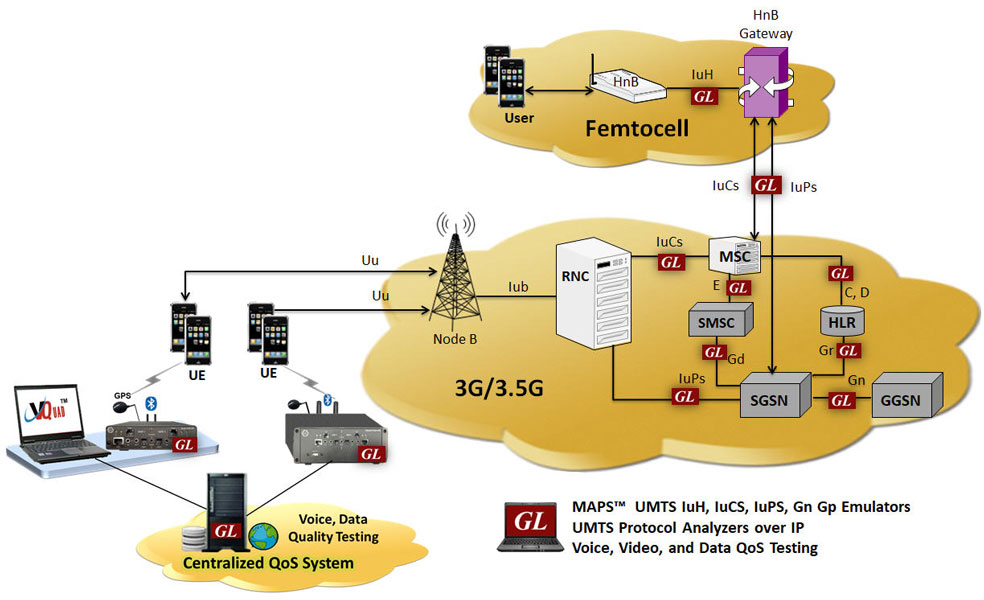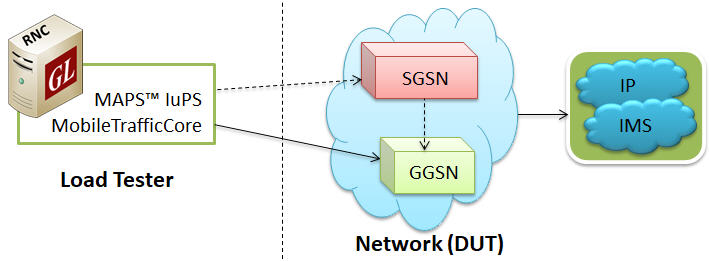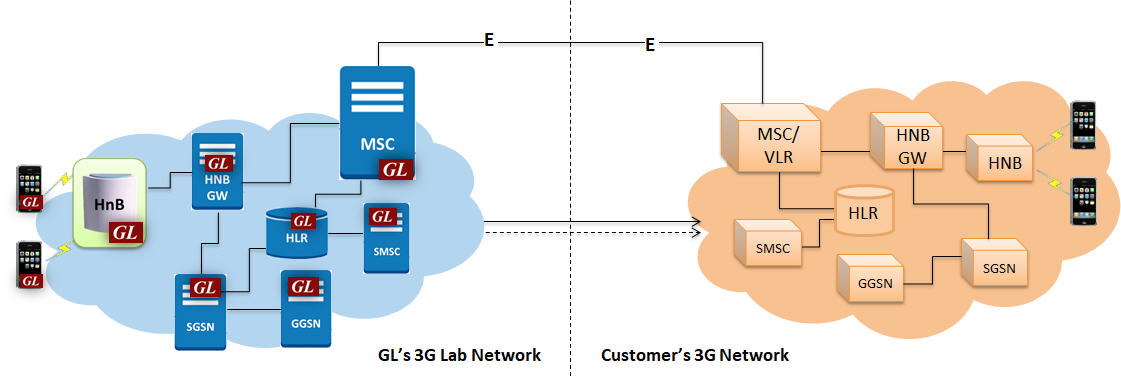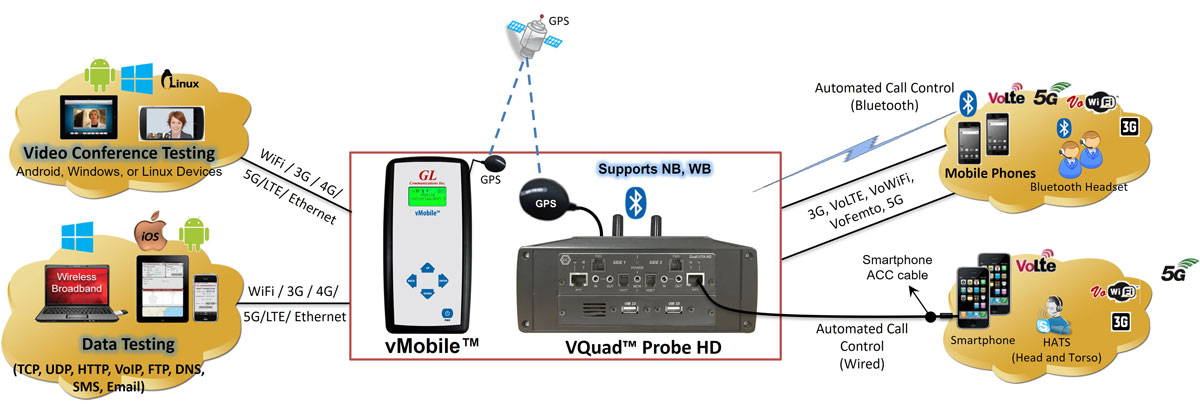3G Network - Analysis & Simulation
Analysis and simulation of UMTS, or Universal Mobile Telecommunications System, a 3rd generation mobile technology with increased spectral efficiency and high bandwidth can support greater data rates for voice and video data to the wireless end users.
Brochure Request a Demo / QuoteUMTS, or Universal Mobile Telecommunications System is a 3rd generation mobile technology that can support greater data rates for voice and video data to the wireless end users. It uses W-CDMA (Wideband Code Division Multiple Access) as radio access. With increased spectral efficiency and high bandwidth, UMTS can support broadband data, voice and video. The underlying transport for UMTS in the core network can be Asynchronous Transfer Mode (ATM), or Internet Protocol (IP).
UMTS supports integrated services such as multimedia and global roaming to mobile users. In essence, UMTS IuPs interface is the Gateway to the World Wide Web. More precisely, IuPs, is the interface between the RNC (Radio Network Controller) and the SGSN (Serving GPRS Support Node).
SGSN manages mobile location whether within the carrier's network or roaming outside. Once a user turns on the device, a new IP address gets assigned and IP connectivity is available with quality of service (bit rate allocation) based on subscription, and tunnels are created for mobile flows to/from that mobile. These data tunnels carry encapsulated traffic such as http, ftp, email, etc. SMS may also be carried by the signaling plane to/from the mobile. IuPs emulation and analysis can be very important in the design, verification, and troubleshooting of a carrier's mobile data network.
The IP based UMTS network consists of the following components -
- NodeB - supporting broadband mobile users
- Radio Network Controller (RNC) - manages radio resources (NodeBs) and routes traffic to circuit and packet switched elements
- Mobile Switching Center (MSC) - circuit switching element for voice
- Serving GPRS Support Node (SGSN) - packet switching element for data and video
- Femto Home NodeB (Femto Cell) - for enhanced coverage indoors and to offload the radio access network
- Femto Home Node Gateway (HnB-GW) - provides wired broadband interface
| 3G Interfaces | Nodes | Products | ||
| Circuit Switched IuCS, IuH Packet-switched Gc, Gr, Gf, Gd, IuPS, Gn Gp, Gi |
MAP Interfaces B, C, D, E, F, H Inter-network Interfaces BICC, CAP, INAP Location Services Lg, Lh |
|
||
GL’s 3G UMTS Test Solutions
GL’s provides fully automated testing solutions for 3G UMTS, and GPRS network as discussed in greater detail below.
The representation of 3G UMTS network above indicates the support of most of the interfaces by GL’s test tools. In summary,
- All elements within 3G UMTS wireless infrastructure can be tested with GL’s general-purpose protocol simulation tool - MAPS™, which supports simulation of various interfaces of 3G UMTS (IuCS, IuPS, IuH, IuPC, GPRS Gb, Gn Gp) interfaces using MAPS™ UMTS IuCS/IuH, UMTS IuPS, GPRS Gb, Gn Gp simulators. With these, one can simulate 3G UMTS calls in lab, and study the network behaviour.
- GL’s PacketScan™ - an All-IP monitoring and analysis probe, along with NetSurveyorWeb™allow centralized monitoring of entire 3G UMTS GPRS network. Wide range of codec support, including AMR WB, and extensive per-call reports
- End-to-end voice, video, and data quality testing with speech metrics such as PESQ, and POLQA. This solution combined with other metrics such as delay, packet loss, drops, and more, the true performance of 3G network can be realized.
Simulation
Functionalities
- Functional testing of UMTS core network elements
- Load testing of UMTS core network elements
- Simulation of NodeB, HNB, HNBGW, RNC, MSC, SGSN, GGSN network elements
- Mobile data (Email, Web-HTTP, and FTP), gateway traffic, and packet traffic simulation up to 40 Gbps
- High volume of RTP traffic (Voice, Digits, Tones, IVR, Video, Fax, Impairments) simulation
- All industry standard Voice Codecs supported
- Simulate multiple NodeBs
- Works with real NodeBs
Procedures
Circuit Switched
|
Packet Switched
|
Inter-network Calls and Roaming Calls
|
Location Services |
Standards
| Test Conformance of UMTS elements to 3GPP standards | |
|---|---|
SCCP |
Q.713, CCITT (ITU-T) Blue Book |
MTP3 |
Q.703, ITU-T Blue Book |
RANAP |
3GPP TS 25.413 V9.1.0 |
MM / CC GMM / SM |
3GPP TS 24.008 V5.16.0 (2006-06) |
RR |
3GPP TS 04.18 V8.13.0 |
SMS |
3GPP TS 03.40 V7.5.0 & 3GPP TS 04.11 V7.1.0 GSM 03.38 version 7.2.0 Release 1998 |
Iu User Plane Interface |
3GPP TS 25.415 |
RUA |
3GPP TS 25468 V9.1.0 |
SSCOP |
ITU-T Q.2110 |
MTP3b |
ITU-T Recommendation Q.2210 |
AAL Type 2 (ALCAP) |
ITU-T Recommendation Q.2630.1 |
RANAP |
3GPP TS 25.413 V9.1.0 |
SCCP |
Q.713, CCITT (ITU-T) Blue Book |
M3UA |
RFC 3332 |
GTP |
TS 29.060 V9.2.0 (2010-03) |
Positioning Calculation Application Part (PCAP) |
3GPP TS 25.453 |
Why MAPS™?
- Single framework for Multi-protocol, Multi-interface simulation
- Script based and protocol independent software architecture
- Affordable-pay only for what you need; simulate all or any network element within Wireless infrastructure
- Unlimited ability to customize the protocol fields and call control scenarios
- Unlimited ability to customize test configuration parameters
- Negative testing using valid and invalid test cases
- Automated Load Testing/Stress Testing with different statistical distribution patterns
- Automated and remote testing with APIs (Python, Java, TCL, and others)
- Support for multi-user testing
- Remote licensing option available for controlling multiple MAPS™ users
- Easy integration with GL’s protocol analysers providing both simulation and analysis solutions
Analysis
Functionalities
- Analyzing signaling across multiple technologies (Mobile, IMS, LTE, UMTS, SIGTRAN, VoIP)
- Monitor calls progressing through advanced 3G or 4G networks from a central location
- Powerful and customizable reporting tools
- Packet Data Analysis (PDA) for live monitoring of signaling and traffic over IP
- Capture IP packets over different transmission lines, including IP, T1, E1, T3, E3, OC-3 STM-1 / OC-12 STM-4
- Identifies, and segregates calls based on signaling and traffic parameters
- Advanced filtering and search option to filter calls-of-interest
Protocols /Standards
| UMTS over IP | |
|---|---|
RANAP |
3GPP TS 25.413 V6.3.0 (2004-09) |
RNSAP |
3GPP TS 25.423 V6.4.0 (2004-12) |
NBAP |
3GPP TS 25.433 V6.3.0 (2004-09) |
M3UA |
RFC 3332 |
SCCP ITU |
ITU-T Q.711-Q.714 |
GMM (GPRS Mobility Management) |
3GPP TS 24.008 V5.0.0 |
CC |
3GPP TS 24.008 V5.0.0 |
MM |
3GPP TS 24.008 V5.0.0 |
RR |
3GPP TS 04.18 V8.13.0 |
GCC (Group Call Control) |
3GPP TS 44.068 V9.0.0 |
BCC (Broadcast Call Control) |
3GPP TS 44.069 V9.0.0 |
SMG (GPRS Session Management) |
3GPP TS 24.008 V5.0.0 |
SMS |
3GPP TS 03.40 V7.5.0 & 3GPP TS 04.11 V7.1.0 GSM 03.38 version 7.2.0 |
| UMTS over ATM | |
|---|---|
ATM |
ITU-T I.361 |
AAL |
ITU-T I.363 |
AAL2 |
Class B (ITU-T I.363.2) |
AAL5 |
Class C & D (ITU-T I.363.5) |
SSCOP |
ITU-T Q.2110 |
SSCF for UNI |
ITU-T Q.2130 (07/94) |
AAL Type 2 (ALCAP) |
ITU-T Recommendation Q.2630.1 |
NBAP |
3GPP TS 25.433 V6.3.0 (2004-09) |
Iub FP |
GPP TS 25.427 V6.1.0 (2004-12) and 3GPP TS 25.435 V6.1.0(2004-03) |
RANAP |
3GPP TS 25.413 V6.3.0 (2004-09) |
Iu-UP |
GPP TS 25.415 V6.1.0 |
MTP3-B |
ITU-T Recommendation Q.2210 |
RNSAP |
3GPP TS 25.423 V6.4.0 (2004-12) |
SCCP ITU |
ITU-T Q.711-Q.714 |
SCCP ANSI |
ANSI T1.112-1996 |
SCTP |
RFC 2960 |
IP |
RFC 791 |
UDP |
RFC 768 |
GMM (GPRS Mobility Management) |
3GPP TS 04.08 V7.19.0 |
GSM CC |
3GPP TS 04.08 V7.17.0 |
GSM MM |
3GPP TS 04.08 V7.17.0 |
SMG (GPRS Session Management) |
3GPP TS 04.08 V7.19.0 |
SMS |
3GPP TS 03.40 V7.5.0 & 3GPP TS 04.11 V7.1.0 GSM 03.38 version 7.2.0 |
AMR |
3GPP TS 26.101 V6.0.0 |
SSSAR |
ITU-T I.366.1 |
UMTS MAC RLC |
3GPP TS 25.321 V6.1.0 and 3GPP TS 25.322 V6.1.0 |
RRC |
3GPP TS 25.331 V6.4.0 |
M3UA |
RFC 3332 |
Why Protocol Analyzer (TDM, IP)?
- Supports ATM as well as IP as the underlying transport layer
- Over ATM, the analyzer is capable of capturing & reassembling frames that were transmitted with Inverse Multiplexing
- Monitor, capture, analyze, and report signaling and user data in real-time
- Call Trace capability over IuCS and IuPS interfaces
- Decodes different control plane protocols i.e. NBAP, RNSAP, RANAP, ALCAP, SSCOP etc and user plane protocols i.e. Iu-UP, Iu-FP, AMR etc.
- Decode NAS protocols (i.e. CC/MM/SM/SMS/GMM) along with the UTRAN specific protocols.
- Streams can be captured on the selected time slots (contiguous or non-contiguous), sub-channels or full bandwidth. Frames may also be contained in either one, n x 64 kbps, or n x 56 kbps data channels.
- Supports ATM mapping, scrambling, and inverse multiplexing (IMA) options
- CRC verification for AAL5 carrying packet data
- Ability to configure VPI/VCI values for PVCs carrying NBAP, RNSAP, RANAP and ALCAP messages
End-to-End Voice, Video and Data Quality Testing
Using GL’s VQuad™ with the Dual UTA HD, or all-in-one VQuad™ Probe, along with centralized analytical tools, voice, data, as well as video quality can be tested simultaneously on a wireless or wired network.
Since the GL’s VQuad™ solution is network independent, all Voice and Data networks are supported including 3G, WiMax, 4G LTE, Advanced LTE and the upcoming 5G. And since the GL VQuad™ solution supports both Narrowband and Wideband traffic, VoLTE testing is fully supported.
GL’s VQuad™ NetTestsolution provides automated data testing on Mobile Devices (Android and Apple) as well as PC based internet connections. The Data Testing includes TCP, UDP, HTTP, FTP, DNS, VoIP, SMS, and Email tests. GL’s Video Application Part (VAC) supports Video Conference testing between any two VAC Agents. GL’s VAC Agents can be installed on any Android device, Win PCs or Linux box. GL’s Voice Quality Testing (VQT) supports automated voice quality between any two nodes within the network using latest ITU based algorithms including Perceptual Objective Listening Quality - POLQA (ITU-P.863) and PESQ (ITU-P.862). The POLQA algorithm is specifically used for testing Wideband voice over networks.
- Complete end to end voice, data, video quality testing of LTE network-visit Automated Network Wide Testing
- Automated test statistics and results across next generation LTE network can be accessed via web interface
- Connect to Mobile Phones, Smart Phones, and Broadband Devices using GL’s portable VQuad™-Dual UTA HD system
- Test LTE devices for Voice, Data, Video quality metrics with complete automation and centrally controlled system
- Use GL’s VQuad™-Dual UTA HD to confirm quality of service during the network upgrade process
- VQuad™ can remotely perform Automated Data Testing on any Android or IOS mobile devices (running the GL NetTest app), irrespective of where the phone is located, and whether the phone is on a voice call or not.
- Perform automated data testing on PC-based Broadband Internet (Broadband 3G/4G/LTE, WiFi, Wired) and on Apple/Android Mobile Devices - tests include TCP, UDP, HTTP, VoIP, FTP, DNS, SMS, UEInfo, SimInfo, and PhoneInfo
- Supported devices - Mobile Radio (PTT) & Mobile Phones (VoLTE, 4G, 3G, Wi-Fi, WiMax)
- Supports both Narrowband (8k sampling rate) as well as Wideband (16k sampling rate) connections for use in VoLTE networks utilizing the AMR-WB codec
Visit Complete Voice and Data Quality webpage for more details.
As an example, the screenshot below illustrates the HD voice quality measurement of calls using POLQA-
- VQT software includes industry standard voice quality analysis algorithms - POLQA and PESQ
- POLQA testing is available for VQuad™ interfaces
- VQT can be configured for fully Automated analysis of recorded voice files
- Full Reference algorithm (FR) measurements with high accuracy for dedicated tests in live networks
- POLQA analysis results include POLQA MOS, E-Model, Signal Level, Noise Level, and Jitter
- Real-time mapping of results with GPS option used in conjunction with VQuad™. Results mapped in WebViewer™ using Google Maps
- The results can be accessed remotely from a database using the WebViewer™, displayed in both tabular and graphic formats
Visit voice quality testing webpage for more details.
Monitoring
Functionalities
- Wireless Network Monitoring and Surveillance System (passive / non-intrusive) –UMTS, GPRS
- Ability to identify and analyze CDR using Key Performance Indicators (KPI’s)
- Ability to listen to the Voice calls
- Set alarm conditions and generate alerts of different types like email alert, visual alert, audible alert, or even log into tables for future analysis
- Reports are displayed both in tabular and graphical formats; customize reports and graphs based on SQL queries
- Graphs provided for Call Completion Ratio, Answer Call, Listening MOS, Conversational MOS, Failure Cause, and Call Duration
- Real-time data displays information such as called number, calling number, source & destination IP address, RTP packet details, call flow graph, frame decodes and more
- Apply single or multiple filters for data analysis; use logical operators between filters
- Ability to export the call detail records displayed based on time filter or record index as PDF and CSV
Typical Applications
- Comprehensive analysis from overall network health to detailed protocol monitoring
- Call Detail Records, fraud detection and location, remote protocol analysis and troubleshooting, real-time signaling monitor, traffic optimization engineering, and statistics.
- Determine actual call signaling routes to verify network functionality under all situations
- Revenue and billing verification, alarm monitoring, intrusive testing.
- Quality of service measurements call trace and recording.
KPIs
- Voice Quality (Listening MOS, Conversational MOS, R-Factor)
- Signaling Performance - Signal level, Nosie Level, and Echo
- Delay Measurements (RTD, OWD)
- Signaling Messages and Traffic Types
- Call Duration and Call Volume (vs Time)
- Call Status (Answered, Completed, Busy, Success, Failure with Failure Cause)
- Call Completion Ratio
- Link Name Message Counters
- Time Duration Message Counters, and Disposition Count
- Average Packet Loss
- Session Request Delay (Successful Calls, Unsuccessful Calls), Session Disconnect Delay
Resources
Please Note: The XX in the Item No. refers to the hardware platform, listed at the bottom of the Buyer's Guide, which the software will be running on. Therefore, XX can either be ETA or EEA (Octal/Quad Boards), PTA or PEA (tProbe Units), XUT or XUE (Dual PCIe Express) depending upon the hardware.
| Item | Description |
|
UMTS Protocol Simulation |
|---|---|
PKS160 |
Message Automation & Protocol Simulation (MAPS™) - UMTS-IuCS |
LTS100 |
|
LTS105 |
Lightspeed1000™ - Portable Dual OC-3/12 STM-1/4 USB Unit (Legacy) |
LTS220 |
OC-3 / STM-1 MAPS UMTS IuCS over ATM, requires LTS214 |
LTS214 |
OC-3 / STM-1 SSCOP Server |
LTS217 |
OC-3 / STM-1 AAL2 Traffic Core |
LTS320 |
OC-12 / STM-4 MAPS UMTS IuCS over ATM, requires LTS314 |
LTS314 |
OC-12 / STM-4 SSCOP Server |
LTS317 |
OC-12 / STM-4 AAL2 Traffic Core |
|
UMTS Protocol Analyzers |
XX165 |
|
OLV165 |
|
XX155 |
|
OLV155 |
Offline GPRS Analyzer |
PKV100 |
PacketScan™ - (Online and Offline) |
PKV103 |
|
PKV109 |
Offline IP Based GSM and UMTS Analyzer (Optional with PacketScan™) |
LTS206 |
|
LTS306 |
|
|
Web Based Monitoring Applications |
PKV170 |
NetsurveyorWeb™ (Perpetual License, Unlimited Users/Nodes) |
PKV169 |
NetsurveyorWeb™ Lite |
| Brochures |
| 3G Networks Test Solutions - Brochure |
| 2G Networks Test Solutions - Brochure |
| 4G Networks Test Solutions - Brochure |
|
GL’s suite of “Wireless Networks Lab Solutions” Brochure |






